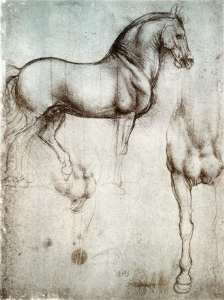
One cannot mention the Renaissance without the name Leonardo Da Vinci coming to the forefront of your mind. He is the epitome of the term, “Renaissance Man”. Painter, mathematician, engineer, cartographer, architect, scientist; all skills Leonardo possessed in a time the world was changing at a maddening pace. Most famously known as an artist for his paintings, such as the Mona Lisa and The Last Supper, it is interesting to note he painted less than thirty paintings in his lifetime, not all of which are completed, yet he was very prolific when it came to drafting.
Born illegitimate but raised by his father, Leonardo apprenticed for Florence artist, Verrocchio before joining an artist’s guild in 1472. Ten years later, Leonardo was sent to Milan as an ambassador for the Medici court. In Milan, he excelled in the intellectual setting, soon immersing himself in ancient texts, scientific studies, as well as his artistic studies. Over the course of his lifetime, he not only opened the world up to scientific thought, but his techniques in art changed the world as well. Portraits went from profiles to an almost frontal view; from a view cut off at the bust, to showing the fine details in the sitter’s hands. It would be foolish to say that Leonardo’s mark was any less than indelible in his paintings, but his sketches and drawings possess a life that seems unbelievable for the period.

This is why I chose Vitruvian Man for my assignment.
There is something entrancing about this simple drawing of a man that demonstrates Leonardo’s understanding of the human body and of proper proportion. It has always struck myself as an abstract ideal when it comes to Humanism, as is the geometrical shapes used in this represent the world, and at the center of it, the individual human. To create a singular man on paper in detail, as if he alone were the only example of Mankind. It is well noted that Leonardo was well-rooted in the humanist movement of the Renaissance, but in pieces such as Vitruvian Man, it is proof that Leonardo was more than a casual student of Humanism.
Works Cited:
Harris, Beth, and Steven Zucker. “About Leonardo.” Khan Academy. N.p., n.d. Web. 17 Sept. 2016. https://www.khanacademy.org/humanities/renaissance-reformation/high-ren-florence-rome/leonardo-da-vinci/a/about-leonardo
“Vitruvian Man.” Wikipedia. N.p., n.d. Web. 17 Sept. 2016. https://en.wikipedia.org/wiki/Vitruvian_Man
“Leonardo’s Horse.” Wikipedia. Wikimedia Foundation, n.d. Web. 17 Sept. 2016. https://en.wikipedia.org/wiki/Leonardo%27s_horse
“Leonardo Da Vinci Biography.” Leonardo Da Vinci Biography. N.p., n.d. Web. 17 Sept. 2016. http://www.leonardoda-vinci.org/biography.html
Your detail of ho he shows his use of humanism is spot on. The realistic and proportionate views of the human body was a new seen in the growth during this period. Using this showed the beauty of the individual. I also chose to write about a piece by Leonardo as well, which was The “Lady with an Ermine”. This portrait represented the human detail and the persist human body which relates to the “Vitruvian Man”. What I would like to know is why paintings weren’t so precise before and if it is just because the realization of the beauty of the human body?
LikeLike
Leonardo is a true genius, and had the talent to do just about anything. The “Vitruvian Man” that he created is a great example of Humanism in this time period. The Medici family had ties with many amazingly brilliant artists that will stand the test of time; including Michelangelo, the brilliant man that I did my blog on.
LikeLike